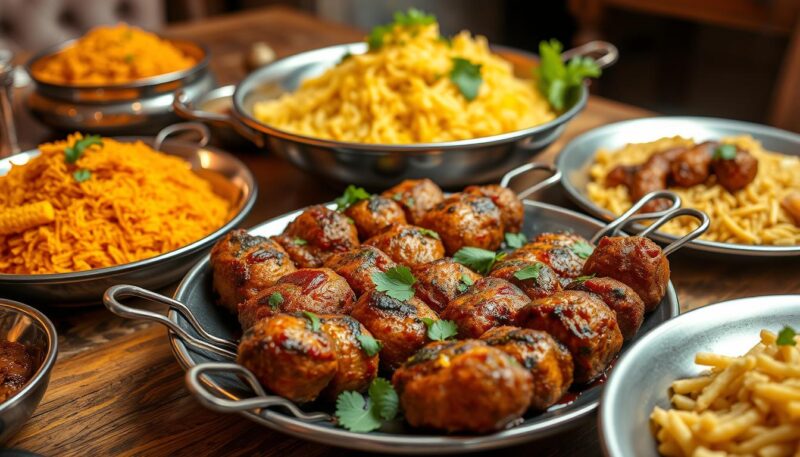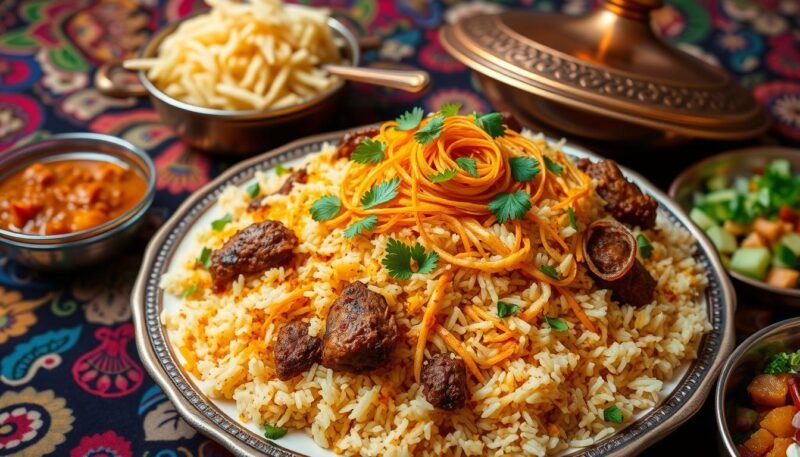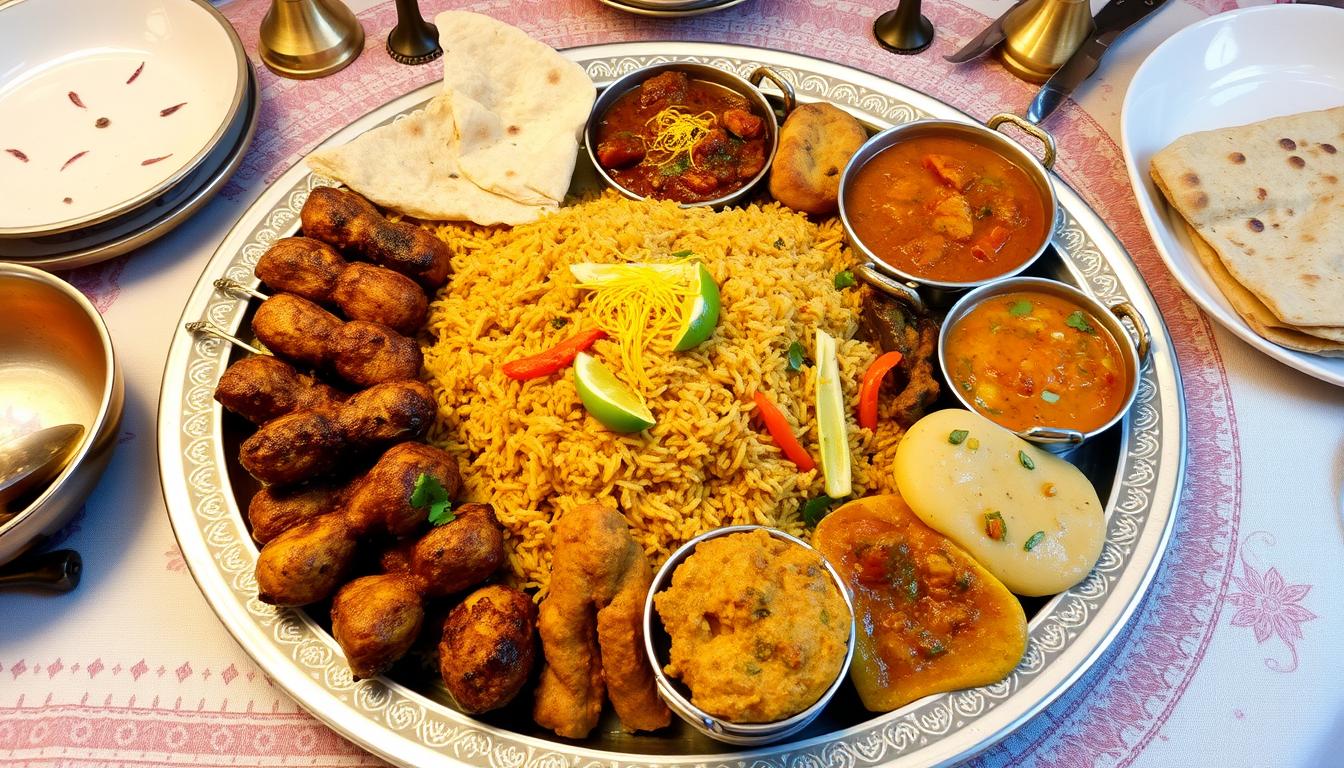Awadhi cuisine specialty is a delectable journey for anyone willing to immerse in the royal flavors of traditional Awadhi dishes. Originating from the land of Awadh, now part of Uttar Pradesh, this cuisine is celebrated for its intricate cooking techniques and lavish use of spices. Awadhi cuisine reflects its rich, Nawabi heritage. A trip to Lucknow, the heart of Awadhi gastronomic culture, unravels the culinary heritage of Awadh through various iconic food joints, where each bite mirrors the grandeur of the erstwhile Nawabi era.
From succulent kebabs to fragrant biryanis, and the splendid kormas, Awadhi cuisine specialties are a testament to the region’s culinary craftsmanship. The ‘dum pukth’ style of slow-cooking in a sealed pot is a hallmark of Awadhi gastronomy, resulting in flavors that are rich, layered, and luxurious. If you are intrigued by the indulgent flavors of royal kitchens, Awadhi cuisine promises an unforgettable experience.
Key Takeaways
- Galouti kebabs use over 150 spices to achieve their melt-in-your-mouth texture.
- The dum pukth cooking style is essential for many traditional Awadhi dishes.
- Kakori kebabs were created for a softer texture after a British complaint.
- Nawab Asaf ud Daula’s cooks specialized in exquisite, highly compensated dishes.
- Lucknow is the epicenter of culinary heritage in Awadhi cuisine.
An Introduction to Awadhi Cuisine
Awadhi cuisine, originating from the city of Lucknow in Uttar Pradesh, India, is renowned for its exquisite flavors that captivate culinary enthusiasts. The roots of Awadhi food trace back to the 18th-century kitchens of the Nawabs of Awadh, making it rich in history and tradition. Known for a delicate balance of flavors and textures, this royal Awadhi cuisine has garnered a global following.
Historical Background
The historical significance of Awadhi cuisine is deeply embedded in the opulent era of Nawab Asaf-ud-Daula, whose kitchen was the epicenter of culinary innovation. The Nawabs of Awadh were patrons of gourmet excellence, employing a legion of highly skilled chefs who created the famous dishes from Awadh that are celebrated today. The competitiveness and precision that ruled these kitchens laid down the foundation for many royal Awadhi recipes that stand the test of time.
Culinary Influence and Techniques
Awadhi cuisine stands out due to its unique culinary techniques and influences. One of the hallmark practices is the ‘dum pukht’ method, which involves slow cooking in a sealed pot to retain the flavors of Awadhi cuisine. Other techniques include ‘bhagona’ and ‘tawa’ cooking that contribute to the distinct taste. Influences from Mughlai, Kashmiri, and Hyderabadi cuisines are evident, resulting in a harmonious blend of spices, textures, and aromas. Signature ingredients like saffron, dry fruits, and ghee are essential in crafting the royal Awadhi recipes we cherish.
The Legendary Kebabs of Awadh
Awadhi cuisine, originating from Lucknow, offers a culinary journey that is both rich and light on the stomach. Among its many delights, the various Awakening kebabs and biryanis stand out for their melange of flavors and masterful use of spices. Distinguished for using aromatic spices in Awadhi cooking, these kebabs are a testament to the gastronomic legacy of the region.

Galouti Kebabs
Renowned as a creation for a toothless nawab, Galouti Kebabs are the epitome of softness and flavor. These kebabs are prepared using finely minced meat marinated with over 150 spices in Awadhi cooking, including unique ingredients like raw papaya, which acts as a tenderizer. This results in a mouth-melting texture that’s hard to resist.
Seekh Kebabs
Seekh Kebabs are a popular street food and a must-have at any Awadhi feast. Made from minced lamb or chicken mixed with a variety of spices, these kebabs are shaped around skewers and grilled to perfection. A squeeze of lemon enhances their spicy flavor, making them a delightful starter in Awadhi kebabs and biryanis.
Shami Kebabs
Shami Kebabs are among the paramount kebabs in Awadhi cuisine. These delicate patties combine minced meat and ground chana dal with a blend of spices. Often served with onions and chutney, their intricate preparation and rich taste reflect the culinary skills honed by Awadh’s noble families.
Kakori Kebabs
Kakori Kebabs have an interesting origin story linked to a British official’s request for softer kebabs. Made from minced meat and raw mangoes, which serve as a natural tenderizer, Kakori Kebabs are distinctly softer and more delicate than other variants. They highlight the creativity and refinement of spices in Awadhi cooking, making them a beloved choice for kebab enthusiasts.
| Kebab Type | Main Ingredients | Unique Feature |
|---|---|---|
| Galouti Kebabs | Minced meat, over 150 spices | Soft enough for a toothless nawab |
| Seekh Kebabs | Minced lamb or chicken, aromatic spices | Grilled on skewers with a squeeze of lemon |
| Shami Kebabs | Meat, ground chana dal | Delicate patties served with chutney |
| Kakori Kebabs | Minced meat, raw mangoes | Exceptionally soft texture |
Iconic Awadhi Biryani
The Awadhi biryani is a jewel among traditional Awadhi dishes, celebrated for its fragrance and delicate flavor. It’s a dish steeped in the culinary heritage of Awadh, showcasing the love for harmony and richness in their cuisine.

Cooking Technique
In the culinary tradition of Awadh, the Awadhi biryani is classified as a ‘pukki’ biryani, meaning it’s cooked with pre-cooked ingredients. The process begins with marinating meat—often chicken or mutton—in yogurt and an array of spices. This marinated meat is then layered with partially boiled rice. Everything is slow-cooked on a low flame, a method known as ‘dum,’ allowing the flavors to meld deeply into the grains of rice.
Ingredients and Spices
The magic of Awadhi biryani lies in its ingredients and spices. Key components include Basmati rice, meat (chicken or mutton), and a selection of aromatic spices such as cinnamon, bay leaves, cardamom, and cloves. A pinch of saffron strands soaked in milk is often added for a distinctive aroma and color. Other notable ingredients include ginger paste, garlic paste, slit green chilies, ghee, and fried onions, contributing to the dish’s depth and richness. Garnishes of fresh coriander leaves and sometimes even dry fruits add a lavish touch to this iconic dish.
| Ingredient | Quantity |
|---|---|
| Basmati Rice | 2 cups |
| Chicken or Mutton | 500 grams |
| Yogurt | 1 cup |
| Ghee | 1/2 cup |
| Thinly Sliced Onions | 3 |
| Garlic Paste | 2 tbsp |
| Ginger Paste | 2 tbsp |
| Green Chilies | 4 (slit) |
| Bay Leaves | 2 |
| Cinnamon Sticks | 2 |
| Cardamom Pods | 4 |
| Cloves | 6 |
| Saffron Strands | A pinch |
| Milk | 1/4 cup |
| Coriander Leaves and Fried Onions (for garnish) | As needed |
The final product of this meticulous process is a dish that reflects the culinary heritage of Awadh, with tender, flavorful meat and aromatic, fluffy rice, making Awadhi biryani a must-try among traditional Awadhi dishes.
The Rich and Flavorful Kormas
Awadhi kormas are a pinnacle of the culinary art of the region, characterized by their sumptuous, yogurt, and cream-based gravies. These dishes reflect the opulence and grandeur of Nawabi cuisine, which is known for its diverse cooking techniques influenced by Mughal, Persian, Kashmiri, Punjabi, and Hyderabadi cuisines. Exploring these rich concoctions allows you to immerse in the authentic flavors of Awadhi cuisine.
Chicken Korma
The Chicken Korma of Awadh is nothing short of a royal feast. Tender chicken pieces are slow-cooked to perfection in a gravy that combines the richness of yogurt, cream, and a variety of whole spices like cinnamon and cardamom which are integral to the cooking styles of Awadh. The addition of coconut cream or melon seed paste in some variations adds an extra layer of flavor, making the dish an aromatic delight.
Mutton Korma
A true testament to the hearty non-vegetarian offerings of Awadhi cuisine, Mutton Korma is a dish that embodies indulgence. The succulent pieces of mutton are cooked slowly to allow the meat to absorb the rich flavors of the spices and cream. This dish is often paired with traditional breads like Warqi Paratha for a complete meal that pays homage to the culinary heritage of Awadh.
Navratan Korma (Vegetarian)
For those who prefer vegetarian dishes in Awadhi cuisine, Navratan Korma offers a wonderful alternative. This dish features a delightful mix of nine different vegetables and fruits, often including paneer, which meld beautifully with the luxurious gravy. Like its meat counterparts, Navratan Korma is infused with the aromatic whole spices that are fundamental to the cooking styles of Awadh.
Traditional Awadhi Breads
The traditional Awadhi breads reflect the rich culinary heritage of Awadh. Each bread has its unique preparation method and taste, seamlessly complementing a variety of flavorful curries and dishes. The breads are more than just side dishes; they play an integral role in enhancing the overall dining experience of Awadhi cuisine.
Ulta Tawa Paratha
One of the most famous traditional Awadhi breads, Ulta Tawa Paratha is thin bread, cooked on an inverted griddle, giving it a distinct, mildly sweet flavor. This unique preparation technique ensures a special texture and taste that pairs well with both vegetarian and non-vegetarian Awadhi dishes.
Sheermal
Sheermal stands as a Persian-inspired bread within the rich Awadhi culinary heritage. Made from dough incorporating milk, sugar, ghee, and saffron, Sheermal is a slightly sweet bread often enjoyed with kebabs and rich curries. Its subtle sweetness perfectly balances the complex flavors of Awadhi meals, making it a beloved choice.
Warqi Paratha
Warqi Paratha, known for its flaky layers, is a must-try among Awadhi bread recipes. The bread is meticulously prepared to achieve a delicate flakiness that beautifully complements the robust flavors of Awadhi curries and kebabs. As one of the traditional Awadhi breads, it truly exemplifies the fusion of textures and tastes characteristic of Awadh cuisine.
Delightful Awadhi Desserts
No exploration of Awadhi cuisine is complete without diving into its exquisite desserts. Known for their rich and opulent flavors, Awadhi cuisine desserts are a culinary embodiment of royal heritage and tradition. These sweet delicacies not only tantalize your taste buds but also offer a glimpse into the cultural significance of Awadhi food.
Kulfi
Among the most celebrated royal Awadhi recipes is Kulfi, a traditional frozen treat that stands out with its dense and creamy texture. Prepared from condensed milk, sugar, and an assortment of nuts, Kulfi is often enhanced with the flavors of rose or saffron. The preparation involves slow-cooking the milk until it condenses and thickens, before being molded and frozen to perfection. This dessert is a true indulgence, resonating with the luxurious culinary legacy of Awadh.
Shahi Tukda
Another iconic dessert in the realm of Awadhi cuisine desserts is Shahi Tukda, a dish that epitomizes richness and decadence. This royal Awadhi recipe features bread slices deep-fried in ghee, soaked in sweetened milk, and generously garnished with dried fruits and nuts. The bread absorbs the flavored milk, resulting in a melt-in-your-mouth texture that is both sumptuous and satisfying. Shahi Tukda is not just a treat for the palate but also a reflection of the cultural significance of Awadhi food, mirroring the elaborate and lavish traditions of the nawabs.
Whether you are savoring the creamy Kulfi or the rich Shahi Tukda, these Awadhi cuisine desserts are the perfect finale to your flavorful journey through the regal tastes of Awadh. They captivate not only with their taste but also with their historical and cultural richness, making every bite a celebration of culinary heritage.
FAQ
What makes Awadhi cuisine unique?
Awadhi cuisine is unique for its deeply rooted history and royal Nawabi traditions. It showcases intricate techniques like ‘dum pukht’ or slow-cooking, and incorporates a blend of meticulous ingredients creating rich, nuanced flavors. The flavors of Awadhi cuisine are a testament to its culinary heritage, combining elements of Mughlai, Kashmiri, and Hyderabadi cuisines.
What are some traditional Awadhi dishes?
Traditional Awadhi dishes include Galouti Kebabs, Awadhi biryanis, and kormas. These dishes reflect the culinary heritage of Awadh, famed for their intricate preparation methods and rich, indulgent flavors.
Can you tell me about the history of Galouti Kebabs?
Galouti Kebabs were crafted for a toothless nawab who yearned for tender meat. They are made with minced mutton, spices, and raw papaya and are renowned for their melt-in-your-mouth texture. This dish truly embodies the essence of Awadhi kebabs and biryanis, with a detailed balance of over 150 spices.
How is Awadhi biryani prepared?
Awadhi biryani is prepared using the ‘dum’ technique where marinated meat and partially boiled rice are slow cooked together on a low flame. Ingredients like saffron, cinnamon, bay leaves, and cardamom are crucial for the dish’s fragrance and flavor, making it an iconic representation of traditional Awadhi dishes.
What makes Awadhi kormas unique?
Awadhi kormas stand out for their sumptuous, yogurt and cream-based gravies infused with a variety of whole spices. Each variety, be it chicken, mutton, or Navratan (vegetarian), reflects the opulence and richness of Nawabi cuisine with its key khada masalas and occasionally enhanced with coconut cream or melon seed paste.
Which traditional breads are popular in Awadhi cuisine?
Traditional breads such as Ulta Tawa Paratha, Sheermal, and Warqi Paratha are integral to Awadhi cuisine. Each bread offers unique textures and flavors, complementing the robust flavors of kebabs and curries, making for a complete and enriching culinary experience.
What are some popular Awadhi desserts?
Popular Awadhi desserts include Kulfi and Shahi Tukda. Kulfi is a rich and creamy frozen treat made with condensed milk, sugar, nuts, and often flavored with rose or saffron. Shahi Tukda is an indulgent dessert featuring deep-fried bread soaked in sweetened milk and garnished with dried fruits and nuts, reflecting the lavish Nawabi traditions of Awadh.
How have traditional cooking styles of Awadh influenced modern cuisines?
Traditional cooking styles like ‘dum pukht’ have influenced modern cuisines by emphasizing the importance of slow-cooking and the precise balance of spices. This technique, intrinsic to Awadhi cooking, has been adopted and adapted across various regional cuisines, highlighting the lasting impact of the culinary heritage of Awadh.
Source Links
- https://www.mishry.com/awadhi-cuisine-20-dishes-you-have-to-try
- https://www.slurrp.com/article/gems-of-awadhi-cuisine-8-dishes-from-this-historical-region-to-try-1696655259030
- https://theawadh.com/evolution-of-awadhi-cuisine/
- https://medium.com/@wethechefs.in/awadhi-food-menu-a-journey-of-flavors-near-you-b29289aa808e
- https://tornosindia.com/awadhi-cuisine-a-legendary-culinary-art-of-nawabs/
- https://thecentrum.in/exploring-awadhi-cuisine-the-rich-flavors-of-lucknow/
- https://100cobbledroads.com/2018/12/27/these-popular-awadhi-dishes-have-a-fascinating-history/
- https://thecentrum.in/the-secrets-of-awadhi-cuisine-a-deep-dive-into-lucknows-royal-flavors/
- https://chennaiexpressbistro.com/exploring-the-flavors-of-awadhi-cuisine-through-biryanis/
- https://tornosindia.com/the-rich-in-taste-and-magic-in-its-aroma-our-best-picks-from-awadhi-cuisine/
- https://food.ndtv.com/food-drinks/awadhi-chicken-navratan-korma-and-more-5-delicious-awadhi-curries-you-must-try-3712330
- https://www.saffrontrail.com/recipe-for-awadhi-arbi-ka-korma/
- http://indianculture.gov.in/food-and-culture/distinctive-cuisines/delicate-flavours-awadh
- https://www.slurrp.com/article/lucknow-cuisine-6-types-of-breads-to-relish-in-the-city-of-nawabs-1691994562491
- https://tornosindia.com/about-awadhi-cuisine/
- https://en.wikipedia.org/wiki/Awadhi_cuisine
- https://food.ndtv.com/food-drinks/5-awadhi-desserts-that-are-an-absolute-must-try-2147687
- https://chennaiexpressbistro.com/savoring-awadhi-cuisines-sweet-side/

